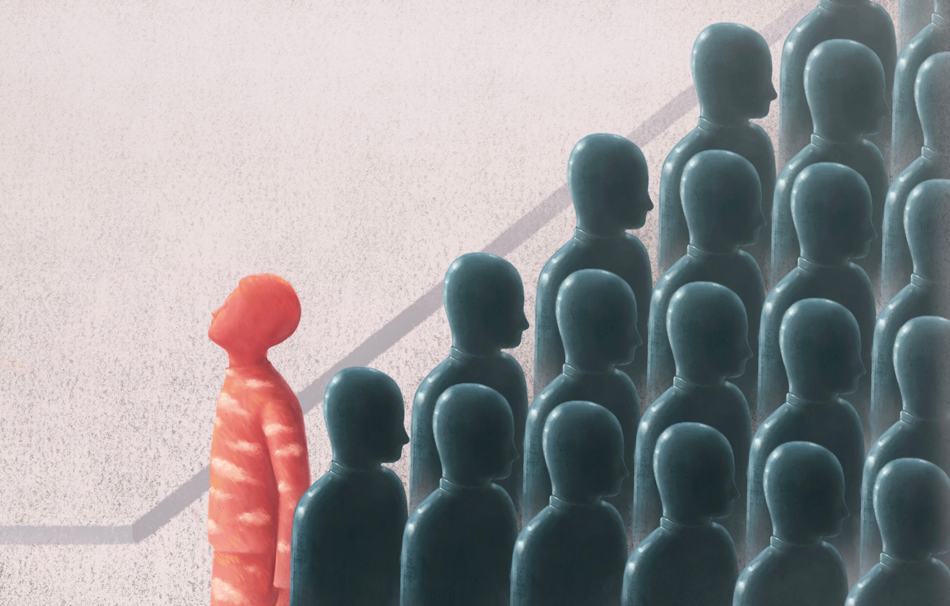
Finding the Right Way Home
John Zada | March 1, 2023
In the mid-1990s, a friend and I attended the gathering of an obscure Christian sect held at an empty warehouse across from the end of a runway beside Toronto’s international airport. Our presence there was as detached observers: the local media was reporting that the group were experiencing strange and unusual phenomena during their weekly musical worship. Church leaders told reporters that God was entering the bodies of their members during services. The result was a panoply of paranormal experiences. Worshippers, the church leaders said, “were being slain in the spirit.”
Up until then, I had always had a fascination with arcane religious sects and cults. One of my earliest childhood memories in front of the television involved watching news coverage of the Jonestown Massacre in Guyana. Another was seeing a 60 Minutes story about the criminal sleights of hand of the Indian guru Bhagwan Rajneesh in Oregon (who later changed his name to “Osho”). I was compelled to see for myself what all of the fuss was about at the warehouse.
My friend and I arrived there to find what seemed to be a regular and informal gathering of music and singing. Nothing seemed out of the ordinary at first beyond the “cliquey” attitude and entranced demeanour of the congregation. But then a switch flipped. The preacher-singer-leader heading the jamboree suddenly announced that it was “carpet time.” As the next song tore through the crowd, and as the music crescendoed, worshippers began falling to the floor in fits of intense euphoria. Some were engulfed in what they called “holy laughter.” Others wept inconsolably for joy. A few members writhed around like snakes, some barked liked dogs, and others roared like lions. One member even woke up from his euphoric stupor claiming that he had magically received gold fillings in his teeth, when before he had none.
We left the gathering scratching our heads. The church’s weekly meetings soon became daily and went on for many years, strangely becoming the most-visited local “tourist destination,” even beating out Niagara Falls.
Yet the experience, for all its strangeness, left me with one overriding question: was this really and truly a cult? Yes, the congregation displayed in-groupishness, utopian ideas and a strong and charismatic leadership. But there also weren’t any of the deep scandals or illegal controversies and exploitation, à la the Branch Davidians in Waco, Texas, for instance, that necessitated the intervention of law enforcement. It seemed to me that something “bad” or “ugly” had to be going on, above and beyond self-delusion, for the group to earn the taboo moniker of “cult.”
It wasn’t too long after that I picked up a book called The Wrong Way Home, written by Dr. Arthur Deikman, a clinical psychiatrist who taught at the University of California in San Francisco and was an authority in cult thinking. I had read other generalist works about cults, but Deikman’s writing, it seemed to me, touched on psychological aspects that were more core and fundamental to the phenomenon.
Deikman identified four main pillars of cult thinking. They are:
- Dependence on a leader
- Devaluing the outsider
- Compliance with the group
- Avoiding dissent
There were two other unique insights that Deikman contributed. First, people are drawn to cults by what he called a “dependency wish” or fantasy—of wanting to be taken care of by powerful, parent-like authority figures that can render everything “okay.”
Just as importantly, Deikman argued that designating cultish behaviour was not an either/or proposition, as I had regarded it when considering the church group I had witnessed. For him, the question was less often: ‘Is this, or isn’t this a cult?’—but more ‘how much cult behaviour is present in any group dynamic?’
“We need to understand the cult behaviour that operates unnoticed in everyday life,” Deikman writes.
Cult-thinking, he adds, is ubiquitous in normal society, and has the effect of obfuscating reality—preventing us from seeing more clearly how things really are, on a case-by-case basis, and in contrast to the fixed views of the group.
After reading his book, I began to see these elements of cultish behaviour in some of my past and present workplaces, in groups I’d been part of, in friendships and family dynamics, and even in my own thinking. These habits can still manifest on occasion. While on a recent work trip to the remote and mountainous border area along the Idaho panhandle and Washington State, a region known for its far-right militia groups, I was divested of my generalized judgements of the area’s people that I held as a more liberal northeasterner. My mind automatically imagined the folks in rugged backwater Republican areas to be low-brow, insular, and hostile to big city people. That didn’t bear out at all. The people I met there were friendly, thoughtful, and generous in the extreme (although, as far as I know I also didn’t run into any militia types).
Larger mainstream political movements, and even whole nations and cultures, it also seemed to me, were just as prone to cult dynamics as individuals. Author Timothy Snyder explores this in his 2017 book, On Tyranny, which looks at the totalitarian movements, the “political cults” that wreaked havoc throughout the 20th century—and which many of us still don’t consider as cults. Even the polarized ideological duelling we see across society nowadays easily falls into Deikman’s catch net of cult-thinking criteria: whether between Democrats and Republicans, Brexiters and Remainers, or Sunnis and Shia.
A society needn’t be in the throes of a historical demagogue, like a Stalin or Pol Pot, to qualify for the cult-like designation. Even what are seemingly well-meaning and “progressive” social movements, can overreach, and become cultish in their pursuit to banish the world’s ills and those deemed responsible for them. Eric Hoffer, in his 1951 classic work, The True Believer: The Psychology of Mass Movements, writes: “Mass movements can rise and spread without belief in a god, but never without a belief in a devil.”
Our human vulnerability to cultishness make sense given we are intensely social creatures, are group-oriented, and fundamentally seek the collective’s approval. Our propensity for group trance, for wanting to sometimes lose ourselves in the emotional throes of the collective, what American social psychologist Jonathan Haidt calls “The Hive Switch”—whether at a football game or at a musical church meeting like the one I attended—is also a deep motivator. Togetherness feels really good.
To be sure a dose of groupishness is needed for the type of cohesion required to bring a collective effort to successful fruition. But the line between a more or less healthy social cohesion on one hand, and tribalism and clannism on the other, is often finer than we realize. We need to remain vigilant and aware of when we may be crossing that boundary into the more dangerous groupthink territory, with all of its diminishing returns.
A dose of self-awareness, too, might be required to better prevent us from falling prey to the more heinous movements we’d more readily call “cults.” Recognizing and thwarting our deep desire for simple, easy, answers about the world that give us a false sense of certainty from an authority figure, is one tranche of work. The other is making sure that our own lives are sufficiently in order, that our emotional needs, are met, so that we aren’t coaxed into situations whereby the cult wrongly provides for those needs for the hefty price they levy in return: our agency.
Author and psychologist Robert Ornstein, in The Psychology of Consciousness, writes:
If someone is unfulfilled in marriage, in work, in self-concept, they are much better off trying to get the fulfilment and stability they need, rather than term it spiritual or conscious development. If you’re hungry, you will seek food in any environment, and if you need recognition, praise, et cetera, you will do so as well.
Were we to understand ourselves, our minds, and our human nature better in this regard, there would be less compulsion to enter into those Faustian bargains that results in what Deikman, astutely calls “diminished realism.”
Indeed, if there is a ‘right way home,’ it would start with moving away from this diminished realism—the fixed, cookie-cutter view of the group—and towards a more flexible and less constrained outlook onto the world that is each our own.
John Zada is a writer and journalist based in Toronto, Canada. He is the author of the books, In the Valleys of the Noble Beyond and Veils of Distortion.
Recent Blogs
- Our Subpersonalities and Many-Sided Selves
- An Old Story About Metaphysics
- The Conditioning Machines in Our Back Pockets
- Out on a Limb: The Danger of our Innate Shortsightedness
- Edward T. Hall: Culture Below the Radar
- The Half Brain Method
- 'He Who Tastes Knows': Contemporary Sufi Studies and the work of Idries Shah
- "They Saw a Game"
- A Funny Thing Happened on the Way to Enlightenment
- Finding the Right Way Home
- Time and Self
- Escaping the Either/Or Thinking Trap
- Looking Up, Looking Out
- Conditioning and the Gendered Brain
- New World, Same Mind?
- One Small Word
- Meaning: The Enduring Gift to Spirit
- Beyond East and West: Human Nature and World Politics
- Forest Smarts: A Part of or Apart From?
- How to Improve Group Decision-Making
- We Know More Than We Think We Do
- How Deep Can a Story Go?
- Lost and Found: An Encounter with the Intuitive Mind
- The Devil’s Tuning Fork
- Welcome to The Human Journey Blog

